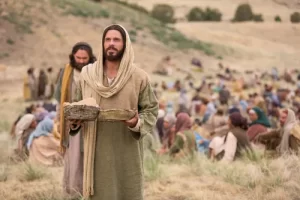The gospel texts teach us in all kinds of ways.
As we meet Jesus there, we can discover much about God and… much about ourselves.

 In today’s celebration, the text of the multiplication of the loaves and fishes is given to our reflection (John 6:1-15).
In today’s celebration, the text of the multiplication of the loaves and fishes is given to our reflection (John 6:1-15).
I am tempted to give it the title: “The human logic and the astuteness of God”!
Some of you reading this may smile, others are puzzled.
What prompts me to think in these terms are the two verses saying something rather intriguing:
“Looking up at the crowds approaching, Jesus said to Philip,
‘Where can we buy some bread for these people to eat”.
He only said this to test Philip;
he himself knew exactly what he was going to do”.
Philip replies with the human logic that knows the practical impossibility of buying food for such crowds in a deserted area –
how can Jesus even think of it!
John, the gospel writer, who might have overheard the conversation gives his own interpretation:
Jesus is testing Philip.
Why? What was Jesus’ purpose in testing Philip?
What did he want his apostle to understand?
We can only surmise that Jesus wanted to teach him something.
We may suppose that seeing what Jesus eventually did – multiply the loaves and fishes – Philip realized a bit more who Jesus was.
But this is a guess, an approximation of the truth, perhaps.
 Catherine of Siena was a 14th century Dominican who became a saint and was eventually recognized as a doctor of the Church.
Catherine of Siena was a 14th century Dominican who became a saint and was eventually recognized as a doctor of the Church.
We are told that “her spirituality was one of radical trust in the providence of God”. *
In her writings, she speaks of “the holy tricks” of the Providence of God!
She goes on to explain that, somehow, God uses such loving ‘tactics’ to draw us to himself.
Clever and astute, the way someone who loves would act!
This is where this gospel text brought me… to meeting a loving astute God whose love goes far beyond our human logic!
Note: Another text is available on a different theme, in French, at: https://image-i-nations.com/17e-dimanche-de-lannee-b-2024/

 World Youth Day is a global gathering where young people deepen their faith, experience the universality of the Catholic Church, and commit their lives to Christ alongside hundreds of thousands of like-minded peers.
World Youth Day is a global gathering where young people deepen their faith, experience the universality of the Catholic Church, and commit their lives to Christ alongside hundreds of thousands of like-minded peers. World Drowning Prevention Day, declared through the April 2021
World Drowning Prevention Day, declared through the April 2021  A few words in today’s 1st reading may bring us some comfort (Jeremiah 23:1-6).
A few words in today’s 1st reading may bring us some comfort (Jeremiah 23:1-6).
 Reading again this long reflection, I find it a description of who a Christian is.
Reading again this long reflection, I find it a description of who a Christian is. World Population Trends
World Population Trends On this Sunday’s gospel text, we meet Jesus teaching in the synagogue, as he usually does on the Sabbat (Mark 6:1-6).
On this Sunday’s gospel text, we meet Jesus teaching in the synagogue, as he usually does on the Sabbat (Mark 6:1-6). The text says:
The text says: